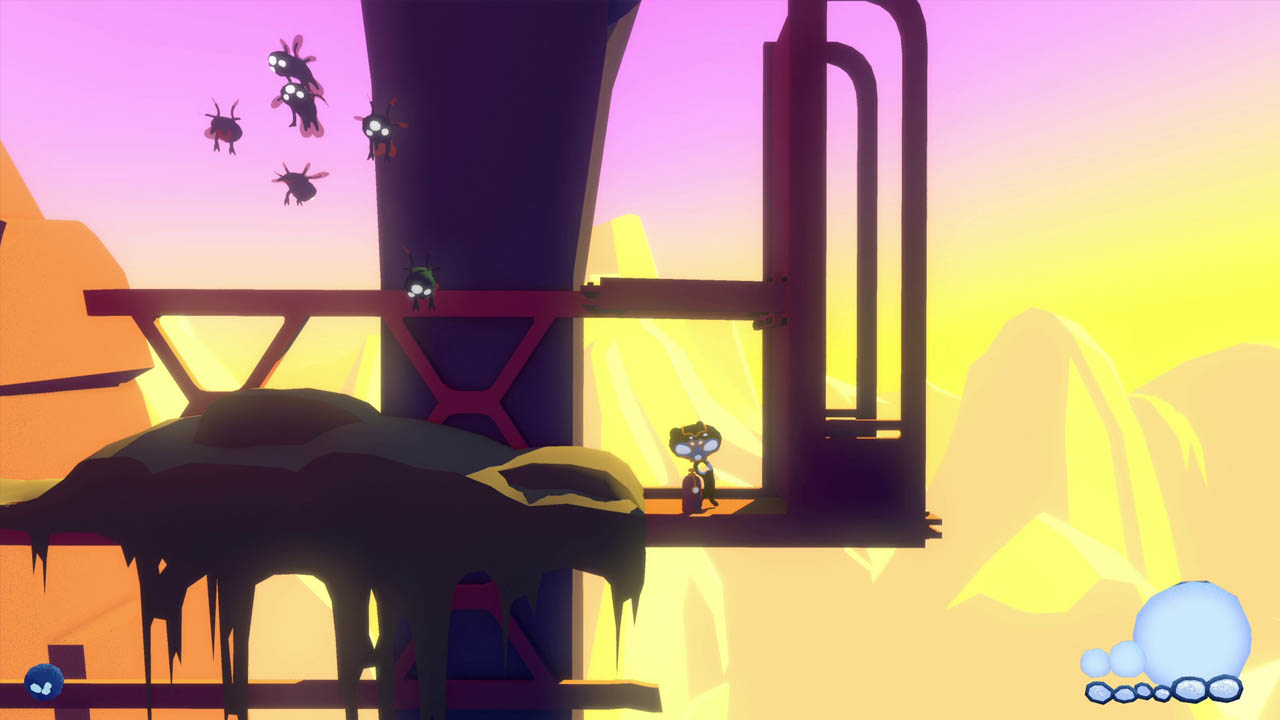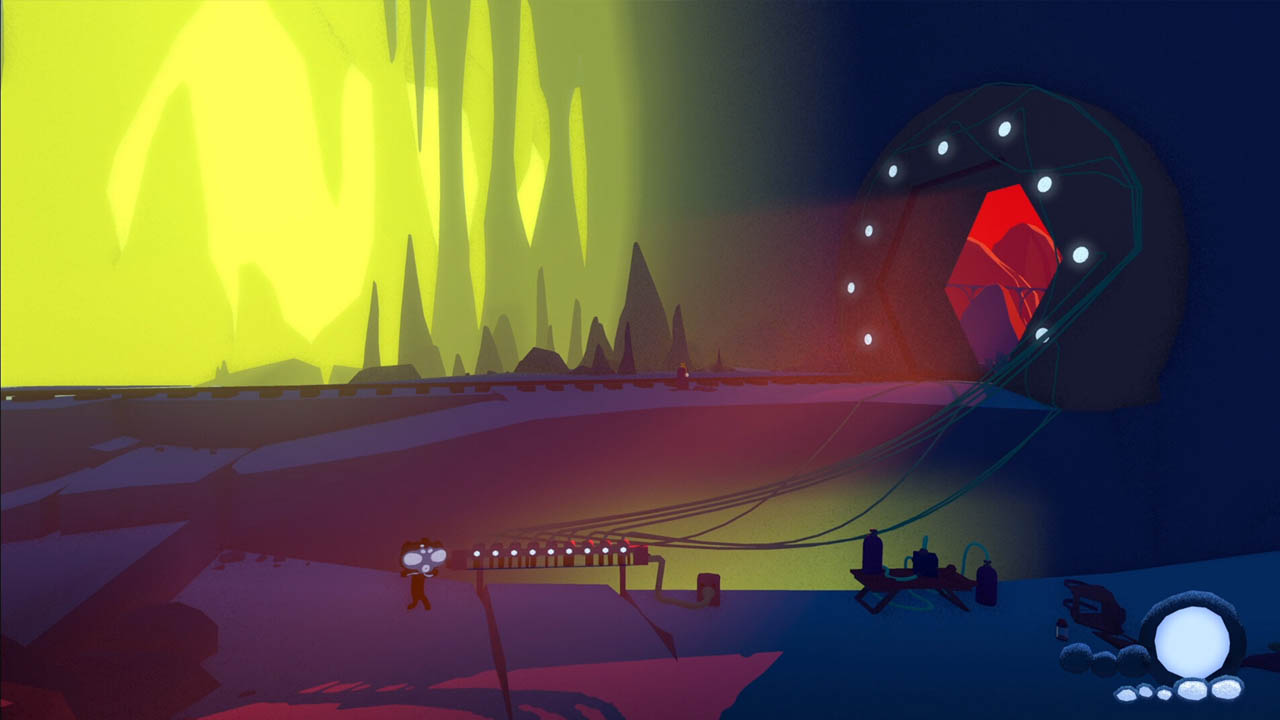Airhead is a game that tries to lure you in with its obscurity but gives you nothing to keep you playing it.
The indie game scene has seen a massive explosion, with more and more innovative games being made by smaller teams. Indie games allow their developers to have more creativity in creating their games and what mechanics they can put in. While, in theory, this sounds like a great thing, artists can now freely create what they want without anyone stopping them, except maybe their hubris. One such game is Airhead, a curious indie puzzle platformer packed with interesting visuals and mechanics that will completely confuse and alienate you.
Airhead was co-developed by two small indie studios, Octato and Massive Miniteam. Both of these studios don’t have much under their belts, especially Octato, whose first and only game is, in fact, Airhead. Massive Miniteam, on the other hand, has quite a small yet impressive roster, mainly consisting of games featuring adorable and wacky characters such as Splitlings and Squishies. In contrast, Airhead does indeed feature its variety of wacky creatures but with a far more severe tone than their other titles.
Now, despite its name, Airhead, we start the game completely headless. At least in the beginning, the main goal is to get a head, pun intended. Now, considering how limited your actions are, getting a head seems to suggest that it will be incredibly useful. Wrong, the head is incredibly detrimental, especially in the beginning. Despite you starting the game headless and surviving just fine without, the second you get the head, suddenly your life depends on it…

Literally, dotted across the world are air tanks; you will use these to reinflate your head and act as save spots. What happens when you run out of air? Oh, you just die and reset at the last save point. This is incredibly frustrating and essentially turns every obstacle you encounter into a timed puzzle, one of gaming’s most disliked puzzles.
This also makes no sense regarding narrative; if the head is so important, why didn’t I already have one? The head you eventually find isn’t originally “your” head and seems to be the remains of a creature that gets crushed to death. What was that creature? Are you its child? Does it grow heads? Was it your head? You are just left with plenty of questions, and sadly, the game will also make zero effort to explain anything about itself,; this is one of the game’s biggest flaws.
Right from the get-go, the game doesn’t give us any direction or hint as to where to go; that’s not saying we’re left completely in the blind as the game does come with a not-so-helpful hint button. This hint button gives cryptic hints as to where we need to go and what we need to do. Now, you would think this would be helpful, but it is quite the opposite. The hints and clues are written so that they come across as snide and cynical most times rather than helpful. It also doesn’t help that they are zone-specific hints rather than quest-specific, which means they change from area to area.
This isn’t exactly a bad thing, as numerous other games have utilized indirect storytelling, most famously Minecraft, Rain World and Valheim. What separates Airhead from these games is that they hint at the main story or guide their players through the story through visual or audio cues. Sadly, Airhead provides none of that; you just wander aimlessly, trying to stumble across the next progression point.

You are supposed to guide your players toward the goal but let them discover it, not just throw them to the wolves and sprinkle in a vague, cryptic message. This does the game a huge disservice as instead of wanting to uncover and piece together the game’s mysteries and secrets, and you scratch your head while wondering if they’ve made any real progress.
This is a shame as the game has some solid mechanics; your Airhead becomes an inflatable multi-tool and becomes increasingly useful with every upgrade. From controlling lifts to becoming a torch, your head adds more and more interesting mechanics to the game and implements them when the story needs them, or at least when you finally figure out where you need to go.
In a sense, the game rewards your exploration but is less earned and more entirely accidental. As for the mechanics themselves, they are spaced out rather strangely. In the beginning, you have to explore a bit to come across your first upgrade, but suddenly, you’re stumbling across them every few minutes.
In a way, the exploration starts making sense once you’ve acquired a new upgrade, and it means you need to just look for what requires the upgrade. An excellent example of this is when you gain the ability to control air valves; valves allow you to either call up or call down lifts.
The second you gain this ability, traversing the first area becomes a breeze and goes from a confusing slog of disjointed puzzles to suddenly clearing rooms like a breeze. While it increases the pace, it does it so suddenly and rapidly that you don’t get enough time to catch up. The game throws up, and the mechanics are around like litter caught in the wind, fitting, considering the game’s world.

As you can probably tell by now, air and all things connected to it play a significant part in the narrative, well, from what we can see. Air is vital to progress through levels. You will often have to use the wind to solve and navigate puzzles, but you will also need to fight against the wind.
It is something that moves you forward but also hinders your progress, much like it has done for the people who once lived in this world. The place is empty and barren, with strong winds moving and powering contraptions that no one controls; it’s eerie and mysterious and wants you to solve it, but the game hasn’t incentivized you.
As mentioned earlier, the world is strange, and we are given no context for what and why we are doing what we are doing. We aren’t even told our character’s name until it’s mentioned in a tutorial. The character isn’t human; we are given no backstory, no name, and nothing to resonate or connect with.
This destroys the mystery the game sets up as we play as an unknown character we can’t connect with, venturing through a world we know nothing about and are just met with more mysteries with little to no reward. Nothing is keeping us going, and your curiosity eventually burns out. That’s not to say it doesn’t pay off; if you stick with the game, it tries to answer most questions, but your reward doesn’t compensate for the time you spent on it.
There is a lot of passion behind the game, and the developers have clearly put a lot of effort into designing an intriguing world. The creatures and the environments look straight out of a strange abstract painting, and the characters are alien and sculpture-like. The colors are solid, and the game also utilizes a strong contrast of colors to separate its backgrounds and foregrounds. It’s hard to appreciate all this effort as you forget about it once you’ve backtracked eight times.
Overall, Airhead is a puzzle platformer that wants you to explore and uncover its meticulously laid-out secrets. Sadly, it’s too afraid to destroy even an inch of the mystery it has so meticulously crafted that it just leaves you wandering in the dark. Unfortunately, this drags the whole experience down as, due to how unclear it is on what you’re supposed to do, you don’t have time to appreciate its unique art style, ambient sound design, and interesting platforming mechanics.
















